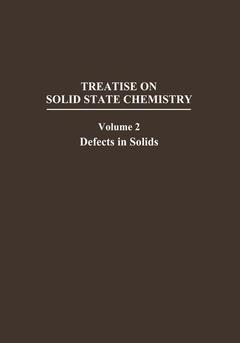Defects in Solids, Softcover reprint of the original 1st ed. 1975 Treatise on Solid State Chemistry Series
Langue : Anglais
Coordonnateur : Hannay N.

The last quarter-century has been marked by the extremely rapid growth of the solid-state sciences. They include what is now the largest subfield of physics, and the materials engineering sciences have likewise flourished. And, playing an active role throughout this vast area of science and engineer ing have been very large numbers of chemists. Yet, even though the role of chemistry in the solid-state sciences has been a vital one and the solid-state sciences have, in turn, made enormous contributions to chemical thought, solid-state chemistry has not been recognized by the general body of chemists as a major subfield of chemistry. Solid-state chemistry is not even well defined as to content. Some, for example, would have it include only the quantum chemistry of solids and would reject thermodynamics and phase equilibria; this is nonsense. Solid-state chemistry has many facets, and one of the purposes of this Treatise is to help define the field. Perhaps the most general characteristic of solid-state chemistry, and one which helps differentiate it from solid-state physics, is its focus on the chemical composition and atomic configuration of real solids and on the relationship of composition and structure to the chemical and physical properties of the solid. Real solids are usually extremely complex and exhibit almost infinite variety in their compositional and structural features.
of Volume 2.- 1 Electronic Structure and Spectra of Impurities in the More Ionic Crystals.- 1. Introduction.- 2. Incorporation of Impurities and Defects in Crystals.- 3. Electronic States of Impurity Ions in Crystals.- 4. Conclusions.- References.- 2 The Imperfect Solid—Color Centers in Ionic Crystals.- 1. Introduction.- 2. Optical Properties—Perfect Crystals.- 3. Color Centers.- 4. Applications: Information Storage.- Acknowledgments.- References.- Chapters 3 The Imperfect Solid—Dielectric Properties.- 1. Introduction.- 2. Introduction to Ferroelectrics.- 3. Pyroelectricity.- 4. Nonlinear Optical Materials.- References.- 4 The Imperfect Solid—Transport Properties.- 1. Introduction.- 2. Electronic Structure of Perfect and Imperfect Solids.- 3. Transport Properties of Solids.- 4. Insulator-Metal Transitions.- 5. Experimental Results.- Acknowledgments.- References.- 5 The Imperfect Solid—Semiconductors.- 1. Imperfections in Crystalline Semiconductors.- 3. Electrical Properties.- 4. Optical Properties.- 5. The Chemical Potentials in Elemental Semiconductors.- 6. The Chemical Potentials for Binary Semiconductor Compounds.- References.- 6 The Imperfect Solid—Magnetic Properties.- 1. Introduction.- 2. Intrinsic Properties.- 3. Effect of Impurities.- 4. Structure-Sensitive Properties.- 5. Lowered Symmetry.- Acknowledgments.- References.- 7 The Imperfect Solid—Mechanical Properties.- 1. Introduction to Plasticity.- 2. Dislocations.- 3. Plastic Deformation of Pure Single Crystal by Slip.- 4. Mechanical Twinning.- 5. Solid-Solution Hardening.- 6. Hardening by Particles of a Second Phase.- 7. Mechanical Properties of Polycrystals.- 8. Fracture.- 9. Anelasticity.- Acknowledgments.- References.
Date de parution : 12-2012
Ouvrage de 528 p.
17.8x25.4 cm
Thème de Defects in Solids :
Mots-clés :
© 2024 LAVOISIER S.A.S.



